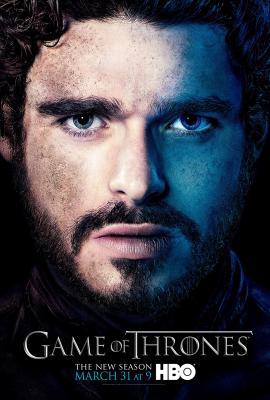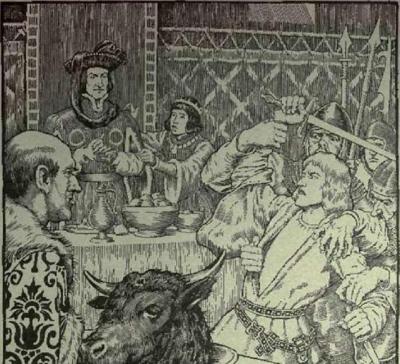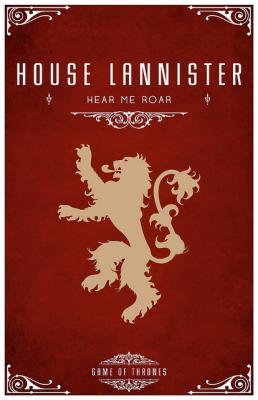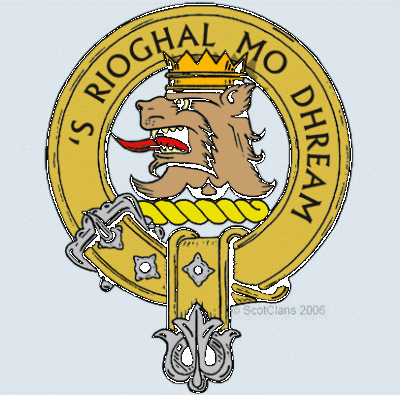Categories
How the Clans Inspired Game of Thrones
by Nadine Lee
If you still haven’t seen Episode 9 ‘The Rains of Castamere‘ in the latest season of Game of Thrones, you should probably stop reading this post right about now.

It’s a well-known and begrudgingly accepted fact that Game of Thrones author George R.R. Martin loves to kill off central characters. In episode nine of the third season of the television series based on the books, three deaths in the space of mere minutes provoked an excessive amount of mortified outcry in almost every media outlet imaginable a few weeks ago. Such shocked reactions are nothing new to Martin – ever since the third book was published a decade ago, he’s been receiving exclamatory emails and letters from heartbroken readers about the disastrous Stark-Tully-Frey union. In a nutshell, three members of the much-loved but ill-fated Stark family and hundreds of Stark bannermen were slaughtered at a wedding, decisively snuffing out the King of the North’s claim to the throne of Westeros.
After heartbreakingly accidentally reading a tiny spoiler via a newspaper, I finally watched the final two episodes of season three a week after the episodes were released. Once the shock subsided and I finally stopped weeping, I was very intrigued to discover that Martin based the fateful ‘Red Wedding’ on two specific events from Scottish clan history. In an interview with EW, Martin said: “No matter how much I make up, there’s stuff in history that’s just as bad, or worse.”
The first event dates back to the fifteenth century, when Clan Douglas were one of the most powerful families in lowland Scotland. Rival families including Clan Crichton felt the Douglases were far too strong and capable of upsetting the delicate power-balance in Scotland at that point. In 1440 King James II was only ten years of age, and the ambitious and influential clan chief William Douglas could have easily gained control of the throne. So Clan Crichton, with the help of Alexander Livingston of Callendar, set out to extinguish the Douglas threat.
In 1440 Sir William Crichton, custodian of Edinburgh Castle, invited William Douglas and his younger brother David to dine with the young king; with the siblings suspecting nothing as the evening proceeded. Near the end of the dinner, a black bull’s head (the symbol of death) was placed on the table by a servant. The two brothers were then seized and dragged out to Castle Hill at the top of the Royal Mile. They were given a mock-trial and accused of various crimes including high treason, before being lead to the headman’s block where they both met a grisly demise with the swing of the executioners axe.

A depiction of the Black Dinner, an inspiration for the Red Wedding
This event came to be known as the ‘Black Dinner’, and just as in Thrones, a family were murdered after the unspoken laws and customs of hospitality were breached. Unsurprisingly the rest of Clan Douglas were quick to retaliate, laying siege to Edinburgh Castle and causing considerable damage. Perceiving the danger, Crichton surrendered the castle to King James who was then given the title of Lord Crichton. This was a politically astute move as challenging the decision would have meant challenging the king himself and left them fighting an unwinnable war against much of Scotland.
The discussion on the laws of hospitality that frequent the final two episodes also eerily draw from the events of the Massacre of Glencoe, which I blogged about earlier this year. In the final episode of the series, Bran speaks of a Lord who killed guests beneath his roof, saying “it’s something the Gods cannot forgive“. In 1692 32 Clan MacDonald members were murdered by Clan Campbell on direct orders from the crown, after providing accommodation to Campbell clansmen for the previous two weeks. The massacre was considered especially awful as it was considered ‘slaughter under trust’, and is still commemorated to this day.
I’m also convinced that Martin based his family/house structures in the series on the Scottish clan system. Every Thrones house has a coat of arms, words, leader, seat and region; just as each clan has their own crest, motto, chief, seat and region. I’ve made a comparison below between House Lannister from the series, and Clan MacGregor:

House Lannister
Words - Hear Me Roar!
Current Leader - Joffrey Baratheon, King of the Seven Kingdoms
Seat - Casterley Rock
Region - The Westerlands

Clan MacGregor
Motto – ‘S rioghal mo dhream (My race is royal)
Current Chief - Sir Malcolm MacGregor of MacGregor, The 7th baronet of Lanrick and Balquhidder
Seat - Bannatyne
Region - Argyll and Perthshire
The clans of Scotland have certainly captured the imagination of Martin, hundreds of years after these fateful events occurred. Like millions of others around the world, I sit with bated breath awaiting the next installment in the Game of Thrones series. Just in case you’re wondering, you can check here how many weeks and days are remaining by visiting www.daystillgameofthrones.com

It’s a well-known and begrudgingly accepted fact that Game of Thrones author George R.R. Martin loves to kill off central characters. In episode nine of the third season of the television series based on the books, three deaths in the space of mere minutes provoked an excessive amount of mortified outcry in almost every media outlet imaginable a few weeks ago. Such shocked reactions are nothing new to Martin – ever since the third book was published a decade ago, he’s been receiving exclamatory emails and letters from heartbroken readers about the disastrous Stark-Tully-Frey union. In a nutshell, three members of the much-loved but ill-fated Stark family and hundreds of Stark bannermen were slaughtered at a wedding, decisively snuffing out the King of the North’s claim to the throne of Westeros.
After heartbreakingly accidentally reading a tiny spoiler via a newspaper, I finally watched the final two episodes of season three a week after the episodes were released. Once the shock subsided and I finally stopped weeping, I was very intrigued to discover that Martin based the fateful ‘Red Wedding’ on two specific events from Scottish clan history. In an interview with EW, Martin said: “No matter how much I make up, there’s stuff in history that’s just as bad, or worse.”
The first event dates back to the fifteenth century, when Clan Douglas were one of the most powerful families in lowland Scotland. Rival families including Clan Crichton felt the Douglases were far too strong and capable of upsetting the delicate power-balance in Scotland at that point. In 1440 King James II was only ten years of age, and the ambitious and influential clan chief William Douglas could have easily gained control of the throne. So Clan Crichton, with the help of Alexander Livingston of Callendar, set out to extinguish the Douglas threat.
In 1440 Sir William Crichton, custodian of Edinburgh Castle, invited William Douglas and his younger brother David to dine with the young king; with the siblings suspecting nothing as the evening proceeded. Near the end of the dinner, a black bull’s head (the symbol of death) was placed on the table by a servant. The two brothers were then seized and dragged out to Castle Hill at the top of the Royal Mile. They were given a mock-trial and accused of various crimes including high treason, before being lead to the headman’s block where they both met a grisly demise with the swing of the executioners axe.

A depiction of the Black Dinner, an inspiration for the Red Wedding
This event came to be known as the ‘Black Dinner’, and just as in Thrones, a family were murdered after the unspoken laws and customs of hospitality were breached. Unsurprisingly the rest of Clan Douglas were quick to retaliate, laying siege to Edinburgh Castle and causing considerable damage. Perceiving the danger, Crichton surrendered the castle to King James who was then given the title of Lord Crichton. This was a politically astute move as challenging the decision would have meant challenging the king himself and left them fighting an unwinnable war against much of Scotland.
The discussion on the laws of hospitality that frequent the final two episodes also eerily draw from the events of the Massacre of Glencoe, which I blogged about earlier this year. In the final episode of the series, Bran speaks of a Lord who killed guests beneath his roof, saying “it’s something the Gods cannot forgive“. In 1692 32 Clan MacDonald members were murdered by Clan Campbell on direct orders from the crown, after providing accommodation to Campbell clansmen for the previous two weeks. The massacre was considered especially awful as it was considered ‘slaughter under trust’, and is still commemorated to this day.
I’m also convinced that Martin based his family/house structures in the series on the Scottish clan system. Every Thrones house has a coat of arms, words, leader, seat and region; just as each clan has their own crest, motto, chief, seat and region. I’ve made a comparison below between House Lannister from the series, and Clan MacGregor:

House Lannister
Words - Hear Me Roar!
Current Leader - Joffrey Baratheon, King of the Seven Kingdoms
Seat - Casterley Rock
Region - The Westerlands

Clan MacGregor
Motto – ‘S rioghal mo dhream (My race is royal)
Current Chief - Sir Malcolm MacGregor of MacGregor, The 7th baronet of Lanrick and Balquhidder
Seat - Bannatyne
Region - Argyll and Perthshire
The clans of Scotland have certainly captured the imagination of Martin, hundreds of years after these fateful events occurred. Like millions of others around the world, I sit with bated breath awaiting the next installment in the Game of Thrones series. Just in case you’re wondering, you can check here how many weeks and days are remaining by visiting www.daystillgameofthrones.com



 Theresa Bradley and Donald like this.
Theresa Bradley and Donald like this.